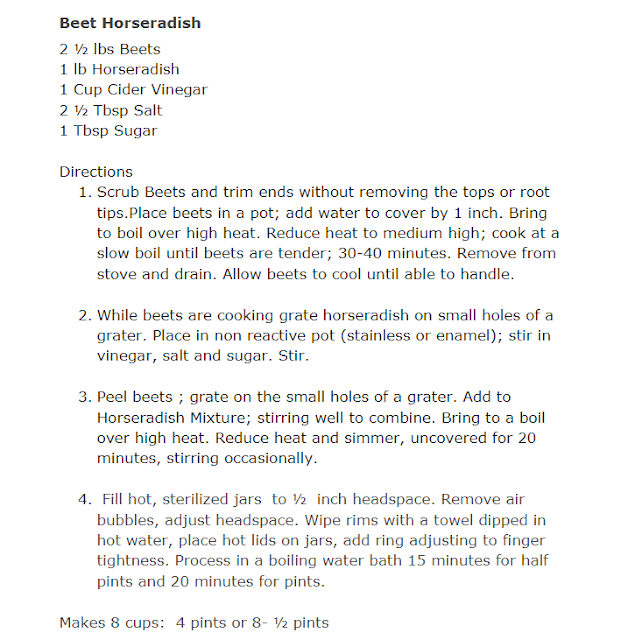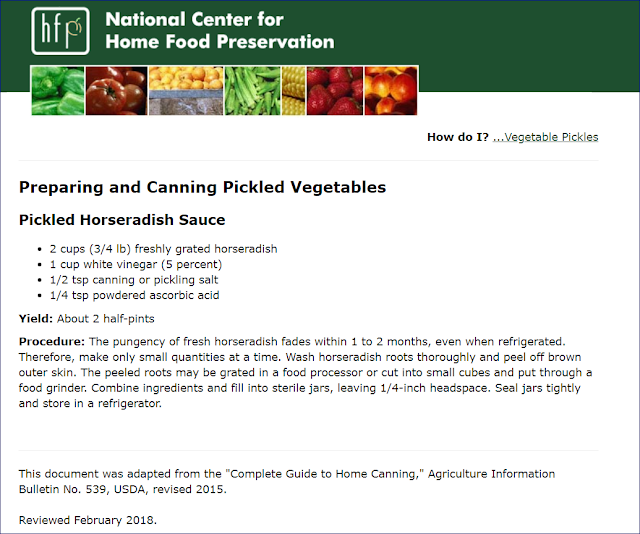Pickled Horseradish Sauce
Seafood Cocktail Sauce
❧❧❧❧❧❧❧❧❧❧❧❧❧❧❧❧❧❧❧❧❧❧❧❧❧❧❧
Beet Horseradish Sauce

❧❧❧❧❧❧❧❧❧❧❧❧❧❧❧❧❧❧❧❧❧❧❧❧❧❧❧
Horseradish Pickles
❧❧❧❧❧❧❧❧❧❧❧❧❧❧❧❧❧❧❧❧❧❧❧❧❧❧❧
Pickled Horseradish Sauce
Pickled Horseradish Sauce

❧❧❧❧❧❧❧❧❧❧❧❧❧❧❧❧❧❧❧❧❧❧❧❧❧❧❧
Drying Horseradish
Horseradish can be dried either sliced or grated, as outlined below:
EQUIPMENT REQUIRED:
Food processor with a slicing attachment OR cutting board and a good, sharp kitchen knife
OR A strong cheese grater vegetable grater trays
For drying the horseradish outdoors:
Wood with wooden slats placed close together, for outdoors
Indoors in your oven:
Metal cookie sheets lined with parchment paper for your oven
METHOD:
1. Slice the clean, peeled horseradish root, either in the food processor or with the knife and cutting board, into uniform thickness.
NOTE: You can also grate the Horseradish in preparation for drying.
2. Spread out in a single layer on the wooden racks or parchment paper on the cookie sheets and place in either heat source. If using an oven, set the temperature at the lowest temperature, or, in the event of a gas stove, the pilot light heat should be sufficient.
3. Place the trays in the sun or in your oven and check occasionally to turn and check on the dryness of the Horseradish pieces.
4. When the Horseradish pieces are dry the discs will be brittle to the touch. Remove from the heat source and allow to cool. Store in a dark container or in a dark cupboard or pantry in a tightly sealed jar.
NOTE: If you have a vacuum sealer, the dried horseradish can be sealed into a vacuum bag and stored in the freezer, or, if your sealer came with a jar sealer, place the dried horseradish into a jar with the appropriate lid and vacuum seal the jar. Place the screw ring onto the top of the lid and tighten to "finger tight". Store in a dark cupboard or pantry away from direct light.
❧❧❧❧❧❧❧❧❧❧❧❧❧❧❧❧❧❧❧❧❧❧❧❧❧❧❧
Freezing Horseradish
The best way to freeze Horseradish is with the use of a vacuum sealer, which will seal out the air and help retain the savory oils that make this root so famous.
EQUIPMENT REQUIRED:
Vacuum sealer with appropriate bags material
Fresh, whole Horseradish Root
METHOD:
1. Wash and trim the Horseradish roots in preparation for freezing.
2. Make a bag large enough to hold the roots by sealing one end of a piece of bag material to form the bottom seal and label the bag with the content and date.
3. Place the Horseradish roots into the bag and seal the loose ends of the bag to form a vacuum seal.
4. Store in the freezer until ready to use.
❧❧❧❧❧❧❧❧❧❧❧❧❧❧❧❧❧❧❧❧❧❧❧❧❧❧❧
Storing Horseradish Whole
The easiest way to store Horseradish is to stick the roots whole into a box of dry sand and place in a cool, dark place through the winter, using the root fresh throughout the winter season.
STORING WHOLE:
EQUIPMENT REQUIRED:
Large, strong box of wood or heavy cardboard
Dry Play Sand
METHOD:
1. Fill the box three-quarters of the way to the top with clean, dry sand.
2. Stick the whole Horseradish root, small side down, into the sand, making sure that there is a void of sand in between each root.
3. Slowly pour more sand over the tops of the Horseradish to cover and place the box in a cool, dry place out of direct sunlight for the winter.
STORING IN VINEGAR:
Drying Horseradish
Horseradish can be dried either sliced or grated, as outlined below:
EQUIPMENT REQUIRED:
Food processor with a slicing attachment OR cutting board and a good, sharp kitchen knife
OR A strong cheese grater vegetable grater trays
For drying the horseradish outdoors:
Wood with wooden slats placed close together, for outdoors
Indoors in your oven:
Metal cookie sheets lined with parchment paper for your oven
METHOD:
1. Slice the clean, peeled horseradish root, either in the food processor or with the knife and cutting board, into uniform thickness.
NOTE: You can also grate the Horseradish in preparation for drying.
2. Spread out in a single layer on the wooden racks or parchment paper on the cookie sheets and place in either heat source. If using an oven, set the temperature at the lowest temperature, or, in the event of a gas stove, the pilot light heat should be sufficient.
3. Place the trays in the sun or in your oven and check occasionally to turn and check on the dryness of the Horseradish pieces.
4. When the Horseradish pieces are dry the discs will be brittle to the touch. Remove from the heat source and allow to cool. Store in a dark container or in a dark cupboard or pantry in a tightly sealed jar.
NOTE: If you have a vacuum sealer, the dried horseradish can be sealed into a vacuum bag and stored in the freezer, or, if your sealer came with a jar sealer, place the dried horseradish into a jar with the appropriate lid and vacuum seal the jar. Place the screw ring onto the top of the lid and tighten to "finger tight". Store in a dark cupboard or pantry away from direct light.
❧❧❧❧❧❧❧❧❧❧❧❧❧❧❧❧❧❧❧❧❧❧❧❧❧❧❧
Freezing Horseradish
The best way to freeze Horseradish is with the use of a vacuum sealer, which will seal out the air and help retain the savory oils that make this root so famous.
EQUIPMENT REQUIRED:
Vacuum sealer with appropriate bags material
Fresh, whole Horseradish Root
METHOD:
1. Wash and trim the Horseradish roots in preparation for freezing.
2. Make a bag large enough to hold the roots by sealing one end of a piece of bag material to form the bottom seal and label the bag with the content and date.
3. Place the Horseradish roots into the bag and seal the loose ends of the bag to form a vacuum seal.
4. Store in the freezer until ready to use.
❧❧❧❧❧❧❧❧❧❧❧❧❧❧❧❧❧❧❧❧❧❧❧❧❧❧❧
Storing Horseradish Whole
The easiest way to store Horseradish is to stick the roots whole into a box of dry sand and place in a cool, dark place through the winter, using the root fresh throughout the winter season.
STORING WHOLE:
EQUIPMENT REQUIRED:
Large, strong box of wood or heavy cardboard
Dry Play Sand
METHOD:
1. Fill the box three-quarters of the way to the top with clean, dry sand.
2. Stick the whole Horseradish root, small side down, into the sand, making sure that there is a void of sand in between each root.
3. Slowly pour more sand over the tops of the Horseradish to cover and place the box in a cool, dry place out of direct sunlight for the winter.
STORING IN VINEGAR:
Large, clean jar with a mouth large enough to fit the roots through
A lid and Screw ring to fit the jar
Fresh, clean Horseradish Root with the tops trimmed off
Vinegar, Usually Apple Cider or White Wine Vinegar
METHOD:
1. Fill the jar half way to the top with vinegar.
2. Place the whole root into the large jar and pour the rest of the vinegar into the jar to within 1 to 1/2 inches from the top and seal.
3. This is an excellent way to store Horseradish, especially if you intend to grate it later. The vinegar can be used to flavor salad dressings and marinades, especially for pork and poultry.
❧❧❧❧❧❧❧❧❧❧❧❧❧❧❧❧❧❧❧❧❧❧❧❧❧❧❧
A lid and Screw ring to fit the jar
Fresh, clean Horseradish Root with the tops trimmed off
Vinegar, Usually Apple Cider or White Wine Vinegar
METHOD:
1. Fill the jar half way to the top with vinegar.
2. Place the whole root into the large jar and pour the rest of the vinegar into the jar to within 1 to 1/2 inches from the top and seal.
3. This is an excellent way to store Horseradish, especially if you intend to grate it later. The vinegar can be used to flavor salad dressings and marinades, especially for pork and poultry.
❧❧❧❧❧❧❧❧❧❧❧❧❧❧❧❧❧❧❧❧❧❧❧❧❧❧❧
Sweet Horseradish Pickles
Four or five pickling cucumbers
1 pint-size canning jar
Quick process pickling mix
4 cups vinegar
Non-metal pot
Tongs to pick up sanitized jars
3/4 cup prepared horseradish
Instructions
1. Choose the cucumbers you want to pickle. The pickling varieties ripe for canning are dark green, with many warts and no developed seeds yet. They are not bloated or distended, which leads to crisper pickles.
2. Sanitize your canning jar in the dishwasher and the lid in a boiled water bath. Sanitizing your can prevents contamination in the pickling process.
3. Boil your pickling mix with vinegar. The pickling mix can be purchased from a grocery store -- look for a "quick process" sweet pickling mix. Add about 4 cups of vinegar unless the directions on the pickling mix packet say otherwise to a non-metal pot with the spices. Heat the mixture until simmering. Simmer for about five minutes.
4. Cut the ends off the cucumbers and cut the cucumbers into spears or rounds.
5. Pack the canning jar by adding the 3/4 cup prepared horseradish to the jar, filling it with the cut pickles, and pouring the hot vinegar solution into the jar until the solution is 1/4 inch from the mouth.
6. Process the jar by sealing with the lid and boiling the sealed jar in a water bath for 10 minutes. This process enables the spices to flavor the pickles.
7. Cool the jars overnight after using the tongs to remove them from the water bath and wait at least 24 hours for the spices to set in. For greater flavor wait two weeks or more.
Four or five pickling cucumbers
1 pint-size canning jar
Quick process pickling mix
4 cups vinegar
Non-metal pot
Tongs to pick up sanitized jars
3/4 cup prepared horseradish
Instructions
1. Choose the cucumbers you want to pickle. The pickling varieties ripe for canning are dark green, with many warts and no developed seeds yet. They are not bloated or distended, which leads to crisper pickles.
2. Sanitize your canning jar in the dishwasher and the lid in a boiled water bath. Sanitizing your can prevents contamination in the pickling process.
3. Boil your pickling mix with vinegar. The pickling mix can be purchased from a grocery store -- look for a "quick process" sweet pickling mix. Add about 4 cups of vinegar unless the directions on the pickling mix packet say otherwise to a non-metal pot with the spices. Heat the mixture until simmering. Simmer for about five minutes.
4. Cut the ends off the cucumbers and cut the cucumbers into spears or rounds.
5. Pack the canning jar by adding the 3/4 cup prepared horseradish to the jar, filling it with the cut pickles, and pouring the hot vinegar solution into the jar until the solution is 1/4 inch from the mouth.
6. Process the jar by sealing with the lid and boiling the sealed jar in a water bath for 10 minutes. This process enables the spices to flavor the pickles.
7. Cool the jars overnight after using the tongs to remove them from the water bath and wait at least 24 hours for the spices to set in. For greater flavor wait two weeks or more.
❧❧❧❧❧❧❧❧❧❧❧❧❧❧❧❧❧❧❧❧❧❧❧❧❧❧❧



No comments:
Post a Comment
Note: Only a member of this blog may post a comment.